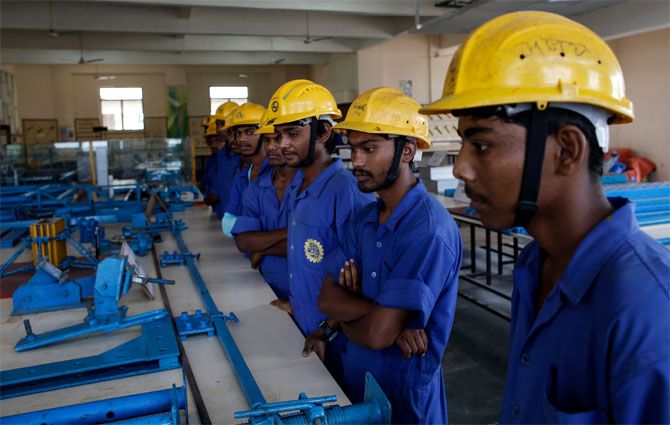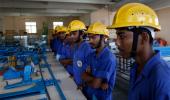The shortage of skilled workers in India is one of the country’s biggest challenges if the goal of reviving the manufacturing sector has to be achieved, says A K Bhattacharya.
 The youngest ministry in the Union government is that of skill development and entrepreneurship.
The youngest ministry in the Union government is that of skill development and entrepreneurship.
But its early journey was a bit slow, even though the mandate of the new ministry was truly grand and central to the success of the government’s Make in India programme.
The ministry’s main objectives were to ensure that the country’s youth acquired job-oriented skills and low-income employees could reskill themselves to explore fresh growth opportunities and improve their productivity.
Consider the slow pace at which the government machinery responded to the idea of the new ministry.
The official notification announcing the formation of the ministry and allocating its business was issued on July 31, 2014, but the new ministry could find a secretary to head it only after about a month.
Two more months passed by before it could have a minister of state with independent charge in Rajiv Pratap Rudy.
A month later, the ministry secured for itself an office in New Delhi.
The shortage of skilled workers in India is one of the country’s biggest challenges if the goal of reviving the manufacturing sector has to be achieved.
As Mr Rudy points out, every Indian wants to be educated, but very few would like to be skilled. Indeed, the share of skilled workforce in developed countries ranges between 60 and 90 per cent of the total workforce.
In India, that share is only five per cent. Worse, an ecosystem for developing skills to meet the needs of industry is yet to be created.
The need for a policy push to promote the idea of skilling the Indian workforce, therefore, cannot be overstated.
Even more disconcerting are data on how the different arms of the government are trying to promote skills development.
More than 20 ministries and departments run over 70 different schemes for skill development. But, according to the government’s own assessment, there are huge gaps in the capacity and quality of training infrastructure. There is also inadequate focus on the need for certification and common standards for skills development.
The new ministry of skill development and entrepreneurship was created to plug the many gaps in such areas.
Last July, the new ministry had launched a National Skill Development Mission with the idea of skilling 400 million people in the next seven years and setting national quality standards with uniformity across the ecosystem.
The goals are ambitious, but some progress has been achieved in the last one year.
Total skill training across different ministries of the Union government has been provided to 10 million people, an increase of 37 per cent over that in 2014-15. Apprenticeship too has seen a 15 per cent increase in its coverage in this period.
In the space of training in the private sector, the number of seats in industrial training institutes has gone up by over 22 per cent to 1.86 million by the end of May 2016, compared to 1.52 million in the same month of 2015.
Similarly, the number of industrial training institutes has gone up by 22 per cent and that of skill training centres is up by 375 per cent in the same period.
The ministry has planned many other new initiatives - some of which are under implementation and some are still under discussion.
For instance, a new law is to be framed to put in place a national skills qualification framework to bring about uniformity in industrial training curricula across the country.
Public sector undertakings are being asked to accept skilled apprentices and interns in larger numbers and special recognition is sought to be granted to industrial training institutes so that their students can upgrade their skills through higher education at a later date.
All this seems to be promising. But two questions should be seriously bothering the new ministry.
One, why is it that it has got only Rs 1,804 crore (Rs 18.04 billion) by way of financial allocation from the government for 2016-17?
Compared to what it got in 2015-16, the amount for the current year represents a huge jump. But if you consider the ambitious goals it has set for itself in the coming years, the new ministry needs greater access to financial resources to implement the many schemes and projects it hopes to launch in the coming months.
The ministry at present has the leanest manpower strength among all departments of the Union government.
According to the government’s own staff strength estimates, it had 49 employees on its rolls at the end of March 2016, significantly up from 31 a year prior to that.
But it hopes to raise the manpower strength to over 2,000 by the end of March 2017.
Even though the ministry might need more resources to spend on skills development, questions are bound to raised about the need to hire so many more people and the appropriateness of this strategy.
The second question is even more important. The Union government collects over Rs 30,000 crore (Rs 300 billion) by way of education cess levied on various direct and indirect taxes.
The Union ministry of human resources development has an annual outlay of over Rs 43,000 crore (Rs 430 billion), of which over Rs 20,000 crore (Rs 200 billion) comes by way of education cess that is collected on various taxes.
If skills development is as important a goal for the government as education, it is perhaps necessary that a part of the education cess is allocated to the ministry of skill development and entrepreneurship.
But will Mr Rudy speak up and demand his share of the education cess?










